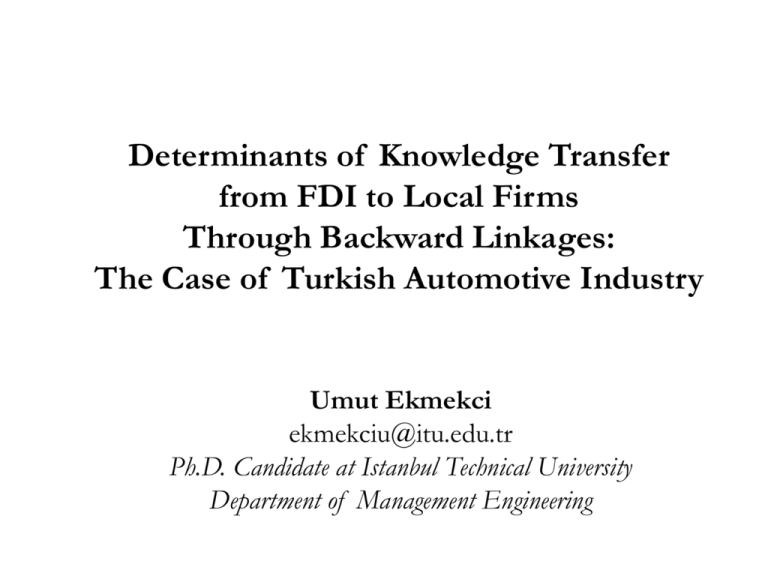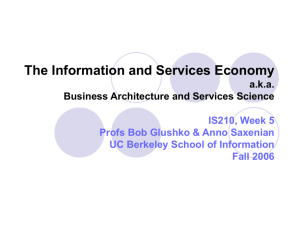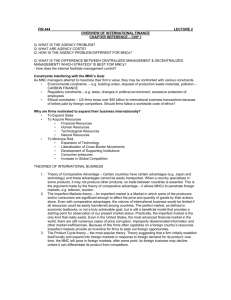Determinants of Knowledge Transfer from FDI to Local Firms
advertisement

Determinants of Knowledge Transfer from FDI to Local Firms Through Backward Linkages: The Case of Turkish Automotive Industry Umut Ekmekci ekmekciu@itu.edu.tr Ph.D. Candidate at Istanbul Technical University Department of Management Engineering Levels of Knowledge Transfer within and between MNCs and Local Actors Foreign Affiliate D Local Competitor Firms Foreign Affiliate B Local Customers Foreign Affiliate E MNC Headquarter Foreign Affiliate C Foreign Affiliate A Local Supplier Firms Local Universities It is assumed that knowledge flows from MNCs to Local Firms through… • “Imitation”, • “Competition”, • “Business linkages” • In the “backward linkages”, – Expectations of MNCs – Direct trainings and technical assistance by MNCs – Engineering rotations, – The movement of skilled personnel from MNCs to local firms – Assistance of MNCs to supplier firms to upgrade their manufacturing infrastructure (Lall, 1980). • “Forward linkages”; the flow of parts and components with advanced technological know-how from multinational supplier firms to local customers (Aitken and Harrison, 1991) The heterogeneity of FDI spillovers… • However, previous researches showed that the existence of FDI in the host country does not automatically generate any positive impact to the host economy (Kokko, 1996; Blomstrom and Kokko, 1998). • In different national, industrial and firm level contexts, contradictory results occurred considering the knowledge spillover impact from FDI. • “there is not strong evidence on their exact nature and magnitude … (except that) host country spillovers vary systematically between countries and industries” (Blomstrom and Kokko, 1998, p:24) • Then, which factors actually determine the level of knowledge transfer from FDI (and MNCs) to local firms? Motivations for Research Subject • The need for a change in the FDI policy agenda in Turkey • The need for a change on the strategy of Turkish automotive industry, • The need to understand in which conditions knowledge can be transferred from FDI, • The need to link different streams of literature • The need to understand the impact of both source and recipient units’ characteristics as determinants of knowledge transfer, Linking different streams of literature Evolutionary Innovation Theory Literature (“Absorptive Capacity” as determinants of knowledge transfer) Organizational Studies Literature (Inter-firm relationships as Determinants of knowledge transfer) MNC Studies (Structure of MNCs as determinants of knowledge transfer) Supply-Chain Studies (Supplier-Buyer Relationships as determinants of knowledge transfer) Levels of Determinants of Knowledge Transfer Macro Level Determinants: Host Country Characteristics Multinational Corporations ’ Foreign Affiliates Multinational Corporations (MNCs) Micro Level Determinants: MNC Characteristics Local Supplier Firms Inter-Firm Level Determinants: Relationship Characteristics Micro Level Determinants: Foreign Affiliates Characteristics Micro Level Determinants: Local Firms’ Characteristics Meso Level Determinants: Industrial Characteristics Determinants of Knowledge Transfer from FDI to Local Firms Macro-Level determinants (national characteristics) -Relative backwardness (Findlay 1978) and technological distance (Glass and Saggi 1998, Borensztein et al. 1998), -Absorptive capacity of host country -Level of education and human capital (Perez and Soete 1988), -Financial markets, openness of market, existence of funding opportunities (Carkovic and Levine 2002, Alfaro et al. 2003) Meso Level Determinants (Industrial Characteristics) -Industrial characteristics, the nature of product (Dunning and Cantwell 1986, Kokko 1994, Lall 1980, Narula and Dunning 2000), Features of Source Unit (Multinational Corporations) -Knowledge stock of source unit (Gupta and Govindarajan 2000); -Corporate strategy and structure of multinational corporations (Altenburg 2000, Blomström and Sjöholm 1999, Rodriguez-Clare 1996), -Diversity among foreign affiliates, their strategies, autonomy and capabilities (Bell and Marin 2004, Birkinshaw and Hood 1998, Todo and Miyamoto 2002), Features of Recipient Unit (Local Firms) Nature of Relationship -Absorptive capacity (Cohen & Levinthal, 1990) -Capabilities of supplier firms -Existence and richness of transfer mechanisms between the units (Subramaniam and Venkatraman, 2001) -Trust (Ghoshal and Bartlett, 1988; Ghoshal et al., 1994), -Time effect (Aitken Harrison 1991, Gorg and Ruane 1998, Driffield and Noor 1999) -Culture (Schein, 1984) Conceptual Model Characteristics of Foreign Affiliates: -Scale of production capacity -Production capabilities -Innovative capabilities -Level of Autonomy -Position in MNC -Strategy in Turkish market -Home country origin -Foreign affiliate’s size -Foreign affiliate’s age Channels of Knowledge Transfer Characteristics of Local Supplier Firms: -Scale of production capacity -Production capabilities -Innovative capabilities -Position in the supply chain -Business Model -Firm size -Firm age Content of Knowledge Transfer Intensity of Knowledge Transfer Characteristics of Supplier – Buyer Relationships: -Volume of Trade -Duration of Relationship -Level of Trust -Tier Level of Supplier Firm Research Methodology • Qualitative research paradigm and explanatory case studies • Foreign affiliates of 7 multinational automotive manufacturer companies and 7 component supplier firms with local capital • Semi-structured face-to-face interviews with the managers / engineers who have longer working experiences in the company and deeper knowledge in general, • At least 2 different respondents from different departments (R&D, product development, production, supplier support & development) to ensure reliability of research, • Recommendations of sectoral representative institutions are taken for choosing case study firms, • Secondary sources: organizational records, annual reports, corporate web sites, the news that published previously in the mass media (e.g. newspapers, Internet, sectoral magazines etc.) • The interviews were tape recorded and fully transcribed unless the interviewee requests in particular not to use tape recording for confidentiality of some part of the interview. • The case studies were completed in 18 months period, started in September 2006 and ended in March 2008. Phases of Research Literature Survey First Phase Exploratory interviews with academics, experts and respondents of sectoral firms Pilot Case Studies Second Phase Explanatory case studies with MNCs Explanatory case studies with local supplier firms Why qualitative approach and case studies? • Case study approach is appropriate in particular when the issue is too complex to understand through surveys or experiments (Yin, 2003), • The complexity of knowledge transfer process, • The value of descriptive details, • The problem of accessing to a large sample to measure large number of variables in quantitative research, • Ensuring accessing to the right person, • Understanding what the respondents really “mean” Interview Questions – Foreign Affiliates of MNCs First Part: • How do you define the general position and strategy of your company in the MNC? • How do you define the strategy of your company in Turkish market? • Does your company perform any product design /development activities? (since when?) • Does your company perform and scientific research activities? (since when?) • How many engineers / scientists / technical person does your company employ being responsible with scientific research / product design / production processes? • Does your company have any patents / patent applications? • Did the production capacity of your company experience any change in time? (what was the major driver behind it?) • How does the decision making process work in your company considering the strategic issues such as shifting to a new production process / new product segment / new product model etc. ? Second Part: • How does your company you select its supplier firms? (what criteria they primarily consider in supplier selection process?) • Through which practices do you exchange knowledge with the supplier firms? • How frequently does your company employ those practices? • How does your company distinguish the supplier firms that exchange knowledge most intensely? • In the history of your company, did your company experience any radical change in the intensity of knowledge exchange with your supplier firms? what caused to this change? Interview Questions – Local Supplier Firms First Part: • How do you define the general position your company in the supply chain of your customer firms? • How do you define the business model of your company? (Manufacturer / Designer / Researcher) • Does your company perform any product design /development activities? (since when?) • Does your company perform and scientific research activities? (since when?) • How many engineers / scientists / technical person does your company employ being responsible with scientific research / product design / production processes? • Did the production capacity of your company experience any change in time? (what was the major driver behind it?) • Does your company have any patents / patent applications? Second Part: • Through which practices do you exchange knowledge with the customer firms? • How frequently does your company employ those practices? • Which customer firms do you exchange knowledge most intensely? What distinguishes those firs from the others? • In the history of your company, did your company experience any radical change in the intensity of knowledge exchange with your customer firms? what caused to this change? Foreign Affiliates of MNCs investigated in this research Automotive Manufacturer Firms Starting Year of Production Total Number of Employees Foreign Capital Licence Product Segment 1983 / 2001 8,254 41 Ford Light Commercial Vehicles 1971 5,258 37.8 Fiat Passenger Cars / Light Commercial Vehicles 1968 / 1985 3,989 85 Mercedes Benz Bus / Trucks MAN 1966 2,778 99.9 MAN Bus / Trucks Toyota Turkiye 1994 3,594 100 Toyota Passenger Cars Hyundai Assan 1997 1,991 70 Hyundai Motor Co. Passenger Cars Honda Turkiye 1994 734 100 Honda Motor Co. Passenger Cars Ford Otosan Tofas Fiat Mercedes Benz Turk Local Supplier Firms investigated in this research Local Supplier Companies Hema Endustri A.S. Uzel Otomotiv Sistemleri A.S. Arfesan Arkan Fren Elemanlari San. Ve Tic. A.S. Akkardan Sanayi Ve Ticaret A.S. Starting Year of Production 1973 1935 1969 1974 Total Number of Employees 1679 Power steerings, hydraulic pumps, hydraulic brakes Ford Otosan, Tofaş Fiat, Mercedes Benz Türk - Ford OTOSAN, Tofaş FİAT, Mercedes Benz, Hyundai Assan, Leaf and Coil Springs, Stabiliser Bars 280 Brake Actuators, Brake Chambers - Ford OTOSAN, MAN Mercedes Benz Turk 400 Propeller Shafts and Components, Axle Shafts Mercedes Benz (Germany), ZF Passau (Germany) Ford OTOSAN, MAN, Mercedes Benz Turk, Hyundai Assan - Ford OTOSAN Mercedes Benz Turk, Honda Turkey - Ford OTOSAN - Tofas Fiat, Ford Otosan, MAN, Toyota 1977 190 Brake Drums, Brake Disks Birinci Otomotiv Sanayi Ve Ticaret A.S. 1970 163 Hot forged, special fasteners, bolts, nuts, pins busher 500 Differential parts, connection rods, forged parts 1974 Continental Teves (Almanya), ZF (Almanya), TRW (ABD) 583 Sesan Yedek Parca Sanayi Ve Ticaret A.S. Kanca El Aletleri Dövme Çelik Makina Sanayi A.S. Licenses Used Principle Customers in Domestic Market Major Products Manufactured Findings – I: Interrelations between determinants • For local supplier firms; the major factors that influence the content, channels and intensity of knowledge transfer from MNC foreign affiliates are; – “self investments to upgrade technological capabilities”, – “production capabilities”, – “innovative capabilities” – “scale of production capacity”, – and “the position of supplier firms in the supply-chain of its customer” • Same logic for MNC foreign affiliates – The position of foreign affiliate in the production and innovation networks within MNC • All these factors are interrelated in an accumulative process Findings II : Accumulation Process of Capabilities • Three phases of capability accumulation: – Accumulation of production capabilities – Accumulation of architectural innovation (design) capabilities – Accumulation of radical innovation capabilities • Investigated firms are in different phases of capital accumulation • In each phase, self efforts, investments and practices are needed to upgrade technological capabilities, and to internalize transferred external knowledge • There are mainly 3 driving forces of capability accumulation: 1. Corporate vision, strategy, motivation, self investments and intra-firm practices 2. Expectations from customers (headquarters) 3. Knowledge transfer from customers (headquarters) through technical drawings and specifications, formal trainings, co-design projects etc. First Phase: Accumulation of Production Capability in Local Supplier Firms Expectation s from customer for higher quality, lower cost Self investment in accumulatio n of production capabilities Reaching to the threshold level of production capability Gaining a position in the supply chain Increasing self investment for upgrading production capabilities Improving production capability Flow of production knowledge from customer Self investment for internalization of transferred knowledge First Phase: Accumulation of Production Capability in Foreign Affiliates of MNCs Expectations from headquarter for high product quality and profit Increasing self investment for upgrading production capabilities Improving production capability Transfer of prior production knowledge from headquarter Self investment for internalization of transferred production knowledge improving the position in the global production network of MNC Increasing production capacity and size of foreign affiliate Second Phase: Accumulation of Architectural Innovation (Design) Capability in Local Supplier Firms Increasing production capability, scale of production capacity + firm size, decreasing production cost Expectations from customers for innovative solutions Self investmen t for upgrading innovative skills Reaching to the threshold level of innovative capability Gaining a position in the supply chain as codesigner Increasing self investment for upgrading innovative capabilities Improving Innovative capability Flow of design knowledge from customer Self investment for internalization of transferred knowledge Second Phase: Accumulation of Architectural Innovation (Design) Capability in Foreign Affiliates of MNCs Increasing production capability, scale of production capacity + firm size, decreasing production cost Expectations from MNC headquarter for innovative solutions Self investmen t for upgrading innovative skills Reaching to the threshold level of innovative capability Increasing self investment for upgrading innovative capabilities Gaining a position in the global innovatio n network of MNC Improving Innovative capability Flow of design knowledge from MNC headquarter Self investment for internalization of transferred knowledge Third Phase: Accumulation of Radical Innovation Capability in Local Supplier Firms Expectations from customers for radically new innovations High innovative capability, and profit margins Self investment in accumulatio n of scientific research capabilities Reaching to the threshold level of scientific research capability Increasing self investment for upgrading innovative capabilities Gaining a position in international supply chains as scientific researcher Improving radical innovation capability Collaborative production of scientific knowledge with customer Self investment for internalization of scientific knowledge Third Phase: Accumulation of Radical Innovation Capability in Foreign Affiliates of MNCs Expectations from customers for radically new innovations High innovative capability, and profit margins Self investment in accumulatio n of scientific research capabilities Reaching to the threshold level of scientific research capability Increasing self investment for upgrading innovative capabilities Gaining a position in international supply chains as scientific researcher Improving radical innovation capability Collaborative production of scientific knowledge with MNC headquarter Self investment for internalization of scientific knowledge Classification of Foreign Affiliates on the Bases of their Technological Capabilities Categorization of Foreign Affiliates First Category Foreign Affiliates Second Category Foreign Affiliates Third Category Foreign Affiliates Fourth Category Foreign Affiliates Production Capacity High High Intermediate Low Production Capability High High High Intermediate Innovative Capability Nature of Innovative Activities Position in MNC High Technological research and product design and development Central position in production network, growing role in innovation network Intermediate Product design and development Central position in production network, minor role in innovation network Low Incremental improvements in production processes Central position in production network Low Incremental improvements in production processes Minor role in production network Classification of Local Supplier Firms on the Bases of their Technological Capabilities Categorization of Supplier Firms Production Capability Innovative Capability Nature of Innovative Activities Position in the Supply Chain First Category Supplier Firms High High System Design and Manufacturing System Developer and Co-Designer Second Category Supplier Firms High Intermediate Component Design and Manufacturing Co-Designer Third Category Supplier Firms Intermediate Low Component Manufacturing Manufacturer Fourth Category Supplier Firms Low Low Component Manufacturing Not Selected Channels of Knowledge Transfer from MNCs’ Foreign Affiliates to Local Supplier Firms COMPANY Technology Developer – Innovative Buyers Product Developer – Innovative Buyers System Developer Supplier Firms Component Designer Supplier Firms Non - Innovative Supplier Firms -Two-directional learning process via co-design projects -Co-design projects -Co-design projects with the headquarter or sister firms of buyer company -Regular technical trainings -Problem solving assistance -Licence agreements with the suppliers of MNC in home countries -Regular technical trainings -Problem solving assistance -Managerial trainings -Technical drawings -Licence agreements with the suppliers of MNC in home countries -Co-design projects -Co-design projects -Co-design projects with the headquarter or sister firms of buyer company -Regular technical trainings -Problem solving assistance -Regular technical trainings -Problem solving assistance -Managerial trainings -Technical drawings Large Scale – Non Innovative Producers -Collaboration for problem solving -Regular technical trainings -Problem solving assistance -Regular technical trainings -Problem solving assistance -Managerial trainings -Technical drawings Small Scale – Non Innovative Producers -Collaboration for problem solving -Collaboration for problem solving -Collaboration for problem solving Content and Intensity of Knowledge COMPANY System Developer Supplier Firms Component Designer Supplier Firms Non - Innovative Supplier Firms Design Knowledge Manufactur ing Knowledge Scien cebased know ledge Design Knowledge Manufactur ing Knowledge - High Intermediate - Intermediate High Low - Intermediate High - Intermediate Intermediate Low Low - Low High - Low High - Low - Low Low - Low Low Sciencebased knowled ge Design Knowle dge Manufac turing Knowle dge Sciencebased knowled ge Technology Developer Innovative Buyers Low High Low Product Developer Innovative Buyers - High Large Scale Non Innovative Producers - Small Scale Non Innovative Producers - Conclusions • The findings of this research indicated that local firms can not simply rely on the existence of backward linkages to transfer advanced knowledge, • What matters most for knowledge transfer is; self-effort, motivation and investments and phase of capability accumulation, • The higher the technology capabilities of local supplier firms, the more central their role in the supply chain of MNCs, and the more intense the transfer of advanced technological knowledge, • The higher the technology capabilities of MNC foreign affiliates, the more central their role in the global network of MNCs, and the more intense the transfer of advanced technological knowledge from MNC foreign affiliates to local firms. • What one can get from a knowledge exchange relationship is proportional to what one can absorb, as well as to what one can offer to the other part,









